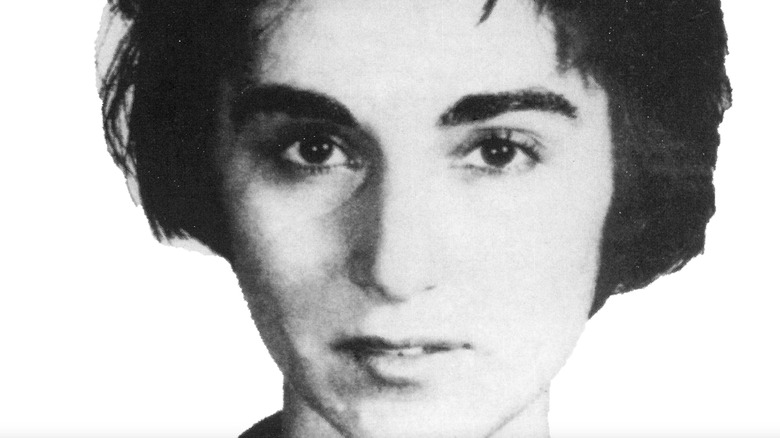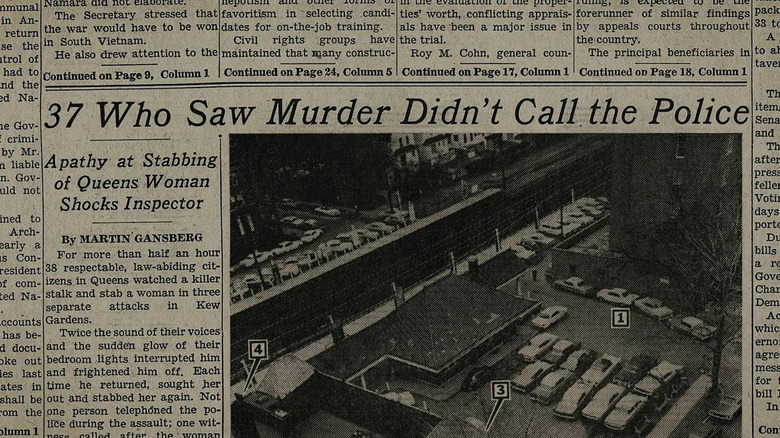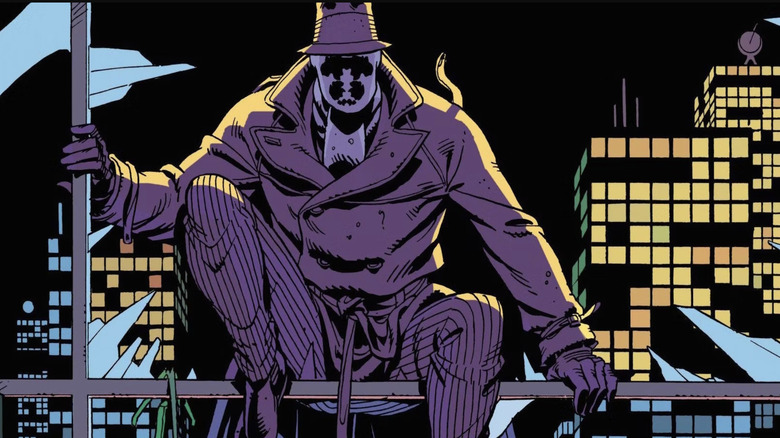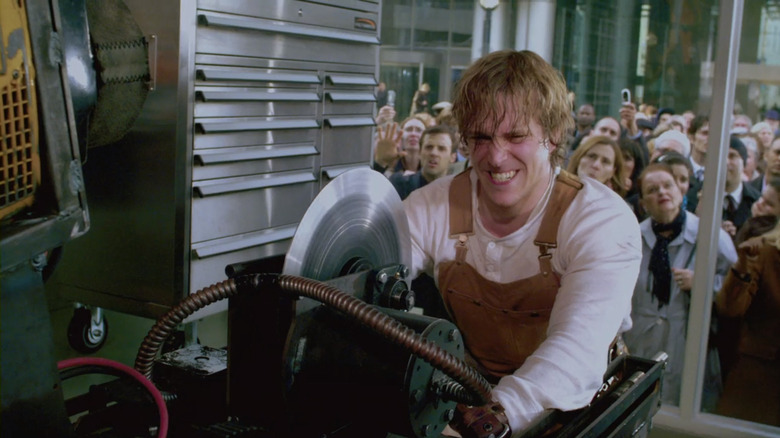Kitty Genovese Keeps On Popping Up In Film And Television – But Everyone Gets The Story Wrong
Now that the "Scream" series is under the stewardship of Matt Bettinelli-Olpin and Tyler Gillett, we're heading into a new era of Ghostface, with the sixth movie leaving Woodsboro and Sidney Prescott behind, and slashing toward the Big Apple as the Carpenter sisters (Melissa Barrera, Jenna Ortega) trying their hardest to start a new life after surviving the previous film. "Scream 5" (aka just "Scream") was structured as a passing of the torch from the franchise started by Wes Craven and Kevin Williamson to the new writing/directing duo, and according to star Melissa Barrera, Ghostface has a major advantage given New York City's massive population. Barrera had told Collider that setting the story in NYC is "like 20 times more mortifying, it's awful," and cited the bustling energy as a major contributing factor:
"Because you also see how, in a city like New York City, everyone is kind of doing their own thing and someone is screaming for help, and no one will come to their help. No one comes to help them, you know, like, everyone's kind of like, 'I'm not getting into that.' So it's mortifying, because you're chased by Ghostface, but you also see humanity and how that reacts in a situation like that. Anyway, I think I've already probably said too much."
What Barrera is describing is something known as "bystander effect," a psychological phenomenon first brought to international attention following a devastatingly tragic real-life murder that took place in NYC back in 1964. It certainly makes for a compelling backdrop of a slasher film, but this theory stems from one of the earliest examples of "viral misinformation," decades before we had a term for it.
The Genovese Syndrome
If you were ever forced to take a psychology class in high school, chances are you've heard of Kitty Genovese. Genovese was a 28-year-old bartender who was raped and stabbed outside of her apartment building in the Kew Gardens neighborhood of Queens in New York City in 1964 by a man named Winston Moseley. Her death is a tragedy, as all deaths are, but erroneous reporting by the New York Times turned this real life woman into a metaphor and the subject of a psychological theory known as the bystander effect or "Genovese syndrome."
The Times claimed that 38 witnesses (despite the headline reading 37) had seen or heard the young woman being attacked, but no one had come to her aid or called for help. When Moseley died in 2016, the New York Times acknowledged their flawed past reporting, clarifying that not only did two people actually call the police, but also that a 70-year-old woman had actually been cradling Genovese as they awaited emergency services. But as host Sarah Marshall so aptly described on an episode of the podcast "You're Wrong About” regarding the Kitty Genovese murder, "Once you tell a story incorrectly once, you can't control where it goes."
The story of Kitty Genovese has been referenced or adapted for decades, like on the shows "Perry Mason," multiple episodes across the "Law & Order" franchise, and "A Crime to Remember," "Silent Witnesses," as well as the film's "Death Scream," "38 Witnesses," "The Echo," and even "The Boondock Saints," all of which present the apathetic urban legend surrounding the murder, rather than the actual events. A 1991 episode of "Law & Order" even has Detective Logan citing the crime by name saying, "It's the post-Kitty Genovese era, nobody wants to look, they think they'll get involved."
The legend became the truth
In one of the most prominent examples of Genovese's story invading pop culture, the popular "Watchmen" comic book series sees a semi-truthful version of the woman as a core source of Walter Kovacs' transformation into the vigilante Rorschach. The comics see her as a woman who hated a dress design manufactured by Manhattan Fabrics, with Kovacs keeping it when she refused to take it. Kovacs learns the following day that the woman had been brutally attacked and murdered while her neighbors looked on and did nothing, inspiring him to turn the dress she had rejected into "face that he could look at in the mirror." This inspiration would be referenced again in the 2020-2021 "Rorschach" comic series.
Genovese's story has continued to pop up in even the most unlikely places, like the "Hello Kitty" episode of "Girls" which sees Hannah attending an interactive theater piece called "38 Neighbors," about the people who supposedly looked on as Genovese was murdered. Her story has become the true crime and horror equivalent to the false sci-fi trope that we only use 10% of our brains, but it's especially egregious considering a woman actually did die. And yet despite all of the information that disproves the story of neighbors looking on and doing nothing, entertainment continues to peddle the idea as if it were factual. The legend of Kitty Genovese follows what I like to call "The Courtney Shane Clause," inspired by her line in the film "Jawbreaker" where she concocts an elaborate lie and claims, "they'll believe it because it's their worst nightmare." We believe the Genovese story because it sounds too harrowing to not be true.
Is the bystander effect real?
While the circumstances that led to the study of the bystander effect weren't based in accuracy, the phenomenon might actually be an accurate pattern of behavior. When people are trained to perform CPR, making eye contact and pointing to someone while directing them to call 9-1-1 is part of the education to combat bystander apathy. The ABC reality show "What Would You Do?" is essentially one giant, televised social experiment testing the theory, and there's a r/DontHelpJustFilm subreddit calling out people who film a tragedy when they should put their damn phone down and do something.
On the flip side, a 2019 study examining street harassment caught on video in Lancaster, Amsterdam, and Cape Town showed bystanders intervening almost every single time, which has been argued is more reflective of the different cultures. Studies have also been done to identify the variables that impact bystander intervention, like the number of bystanders, group cohesiveness, and diffusion of responsibility. So is the bystander effect real?
Well, it depends on a multitude of factors, and it's nearly impossible to predict how an individual will behave unless actually faced with a dangerous situation, because our fight/flight/freeze/fawn responses are all going to be different. The film "Saw VII" opens with three individuals in a trap in front of an audience, and while there are those that pull out their phones and don't intervene, there are plenty who call for help and try to get them out. A person who may be willing to help an old lady who just had her purse stolen on the street might not be willing to throw down with Ghostface to save a stranger, but that doesn't mean there aren't people out there who would be willing to help.



